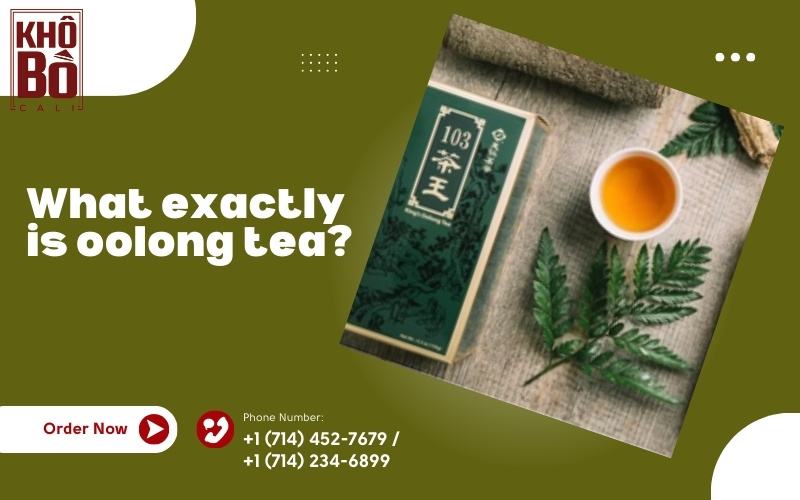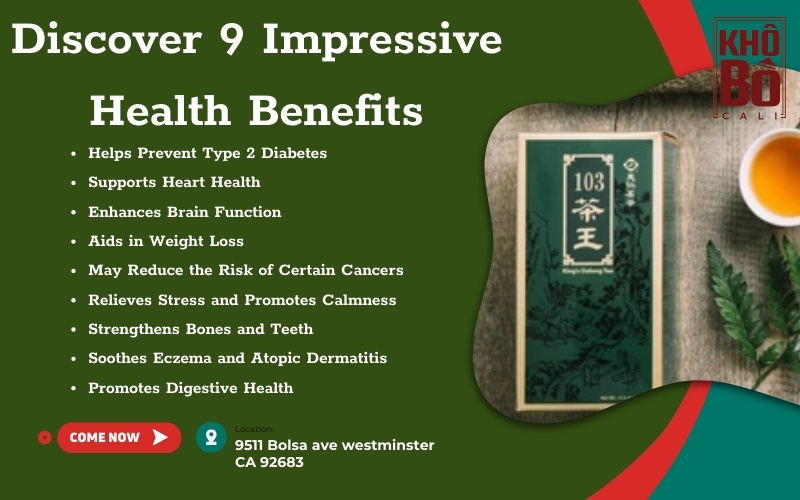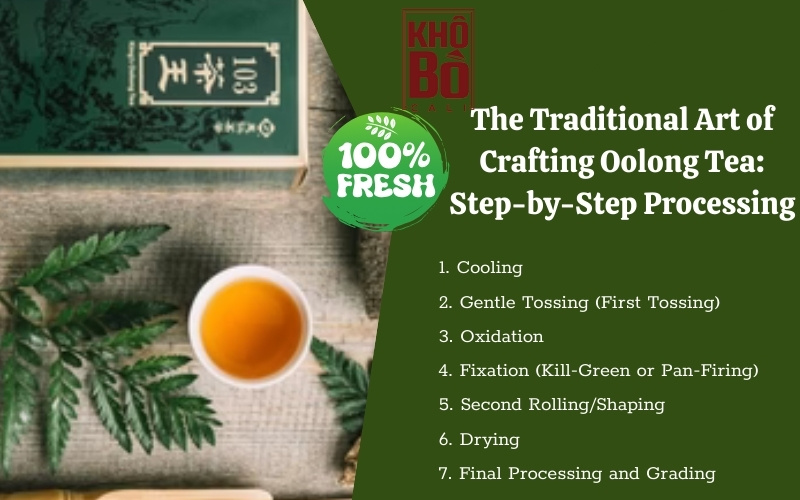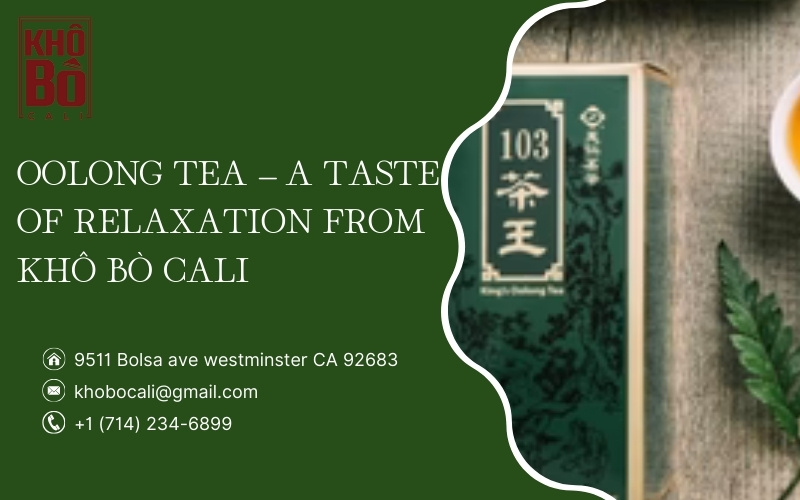Do you enjoy sipping a cup of oolong tea during your free time or while chatting with kindred spirits? This relaxing habit not only helps with stress relief and weight management but also aids in preventing various health conditions such as diabetes, heart disease, and even cancer.
Oolong tea is partially oxidized green tea, which allows it to retain its delicate, refreshing flavor along with a wealth of beneficial nutrients. So, what are the effects of oolong tea? Let Khô bò CALI guide you through the remarkable health benefits of this precious herbal drink.
What exactly is oolong tea?
Oolong tea is a traditional Chinese tea that falls somewhere between green tea and black tea in terms of oxidation and flavor. It is made from the leaves of the Camellia sinensis plant — the same plant used to produce green and black teas. However, what sets oolong apart is the unique and carefully controlled oxidation process it undergoes, which typically ranges from 10% to 80%. This process gives oolong tea its distinctive aroma, complex flavor profile, and an impressive range of colors and textures.

Depending on the specific production method and the tea brand, the leaves of oolong tea can vary in appearance — from bright green with tightly rolled shapes to dark brown with long, twisted strands. These visual differences often reflect subtle variations in taste, ranging from light and floral to bold and toasty.
With its unique combination of properties, many tea lovers find themselves asking: what are the effects of oolong tea? Beyond its rich taste and cultural heritage, oolong tea is also praised for its many health benefits, which include supporting metabolism, enhancing mental alertness, and promoting overall well-being.
Nutritional Composition of Oolong Tea
Oolong tea is not only appreciated for its distinctive flavor and cultural significance, but also for its rich nutritional profile. One of the primary active compounds found in oolong tea is caffeine, which helps promote alertness and boost energy levels. However, its health-boosting benefits go far beyond just a caffeine kick.
This traditional tea is also packed with a wide variety of vitamins, minerals, amino acids, and antioxidants that contribute to overall wellness. Among the most notable antioxidants are polyphenols, a group of plant-based compounds known for their powerful free-radical fighting abilities. Oolong tea contains several key polyphenols, including theaflavins, thearubigins, and epigallocatechin gallate (EGCG) — all of which have been studied for their potential roles in reducing inflammation, improving heart health, and even supporting weight management.
Another important compound found in oolong tea is L-theanine, an amino acid renowned for its calming and stress-reducing properties. L-theanine is known to promote mental clarity and relaxation without causing drowsiness, making oolong tea an ideal beverage for those seeking both focus and tranquility.
Thanks to this well-rounded blend of nutrients, oolong tea serves as both a delightful drink and a natural wellness enhancer. No wonder so many people are curious to learn: what are the effects of oolong tea?
Readmore: The best crispy fried okra recipe that’s irresistibly delicious and incredibly easy to make
What Are the Effects of Oolong Tea? Discover 9 Impressive Health Benefits
Oolong tea is more than just a flavorful beverage—it’s a natural elixir packed with powerful compounds that can significantly boost your health. Rich in vitamins, minerals, amino acids, and polyphenol antioxidants, oolong tea has been linked to a wide range of health benefits, from improving heart health to supporting digestion. Let’s dive into what are the effects of oolong tea and why it deserves a spot in your daily routine.

Helps Prevent Type 2 Diabetes
Oolong tea is loaded with polyphenols, which are known to help lower blood sugar levels and enhance insulin sensitivity. These antioxidants work to stabilize blood glucose, making oolong tea a supportive beverage for those managing or at risk of diabetes.
Several scientific studies have highlighted the link between regular oolong tea consumption and improved blood sugar control. One such study found that individuals who drank around 720 ml of oolong tea daily had a 16% lower risk of developing type 2 diabetes compared to non-drinkers.
Supports Heart Health
The antioxidants in oolong tea not only combat oxidative stress but also promote cardiovascular well-being. Regular tea consumption has been shown to lower blood pressure, reduce cholesterol levels, and decrease the risk of heart-related diseases.
In one study, people who drank over 1.4 liters of tea per day were found to have a 51% lower risk of heart disease. More specifically, those who consumed about 240 ml of oolong tea daily saw their risk drop by an impressive 61%. Even consuming just 120 ml daily of green or oolong tea may help reduce the risk of high blood pressure by up to 46%.
Enhances Brain Function
Oolong tea may also play a role in preserving cognitive function as we age. Research suggests that drinking tea regularly helps maintain brain health, boost memory, and protect against age-related neurodegenerative disorders.
The caffeine in oolong tea stimulates the release of norepinephrine and dopamine, which are associated with improved mood, alertness, and brain performance. Meanwhile, L-theanine, an amino acid in tea, works synergistically with caffeine to enhance focus and reduce anxiety.
A 2008 study revealed that regular tea drinkers experienced less cognitive decline, with the most significant effects observed in those who consumed black or oolong tea consistently.
Aids in Weight Loss
Oolong tea has gained attention for its potential to assist with weight management. Scientists believe that the polyphenols in the tea can boost metabolism, reduce fat absorption from food, and activate enzymes that help burn stored fat.
Research shows that drinking oolong tea may help your body burn an additional 2.9% to 3.4% of total daily calories. This thermogenic effect is attributed to both caffeine and polyphenols, making oolong tea a natural ally for those trying to lose or manage weight.
May Reduce the Risk of Certain Cancers
The antioxidants in oolong tea are thought to inhibit cellular mutations and slow down the growth of cancerous cells. Studies have shown that regular tea consumption may lower the risk of several cancers, including oral, lung, esophageal, pancreatic, liver, and colorectal cancers.
One recent study found that people who drank tea regularly had a 15% lower risk of developing oral cancer. However, evidence remains mixed regarding its effects on breast, ovarian, and bladder cancers, and more research is needed to draw definitive conclusions.
Relieves Stress and Promotes Calmness
Oolong tea is traditionally valued for its ability to soothe the mind and calm the spirit. Modern research supports this use, suggesting that certain amino acids in the tea leaves may inhibit glutamate receptors in the brain—one of the key contributors to stress and mental fatigue.
Regular consumption can help reduce tension, regulate blood flow, and even alleviate headaches, making it an excellent beverage for mental wellness and emotional balance.
Strengthens Bones and Teeth
Thanks to its antioxidant content, oolong tea may help maintain stronger bones and healthier teeth. One long-term study showed that individuals who drank black, green, or oolong tea for over 10 years had 2% higher bone density than non-tea drinkers—suggesting a protective effect against fractures.
Additionally, oolong tea is a good source of fluoride, which helps protect tooth enamel and prevent cavities. It has also been shown to reduce dental plaque buildup, supporting better oral hygiene.
Soothes Eczema and Atopic Dermatitis
Studies on green and black teas have shown promising results in reducing symptoms of eczema (atopic dermatitis), and oolong tea appears to share these benefits. The polyphenols in the tea may help reduce inflammation in the skin and enhance healing when combined with standard treatments.
In some cases, individuals suffering from chronic eczema noticed significant improvement within one to two weeks of consuming oolong tea. However, responses may vary depending on the individual’s skin condition and overall health.
Promotes Digestive Health
Oolong tea has natural anti-inflammatory and antiseptic properties, which can help soothe the digestive tract. It may be particularly beneficial for individuals dealing with acid reflux, gastric ulcers, or indigestion.
By helping to calm the gut and inhibit the growth of harmful bacteria, oolong tea supports a healthier gastrointestinal environment, making it a gentle yet effective remedy for common digestive issues.
The Traditional Art of Crafting Oolong Tea: Step-by-Step Processing

Oolong tea is renowned not only for its distinctive flavor and rich aroma but also for the meticulous craftsmanship involved in its production. Every step in the process—from withering to drying—is essential in shaping the tea’s character. Here is a closer look at the traditional method of crafting oolong tea:
1. Cooling:
After the tea leaves are harvested and sun-withered, they must undergo a cooling period. This allows the residual heat accumulated during the initial drying phase to dissipate. Once fully cooled, the leaves begin to wilt naturally, becoming softer and more pliable—an important precursor to the next stages of processing.
2. Gentle Tossing (First Tossing):
The leaves are then gently tossed or rolled in large bamboo trays or rotating drums. This process is essential for shaping the leaf and kick-starting oxidation. The mechanical tossing slightly bruises the leaf edges, rupturing cell walls and allowing natural enzymes and essential oils to emerge. This interaction with oxygen marks the beginning of the chemical changes that create oolong’s signature taste and aroma.
3. Oxidation:
One of the most critical stages, oxidation determines the final color, flavor, and aroma of the tea. Oolong teas are partially oxidized—ranging from as low as 8% to as high as 80%—depending on the desired style and the artisan’s technique. During this phase, enzymes react with oxygen, transforming the tea’s chemical composition and enhancing its floral, fruity, or roasted notes.
4. Fixation (Kill-Green or Pan-Firing):
Once the desired oxidation level is achieved, the leaves are exposed to high heat to halt further enzymatic activity. This is usually done through pan-firing or steaming. The heat deactivates the enzymes, locks in the flavor profile, and begins the dehydration process.
5. Second Rolling/Shaping:
At this point, the tea is rolled a second time—this stage defines oolong’s characteristic appearance. Whether tightly balled or twisted into long curls, the shape is carefully crafted through repeated rolling. This also helps squeeze out excess moisture and further blend the leaf’s inner compounds for a more complex flavor.
6. Drying:
The rolled tea leaves are then thoroughly dried using hot air or a low-temperature roasting process. This crucial step ensures the tea is fully dehydrated, which preserves the tea, enhances its aroma, and prepares it for storage. A well-dried oolong tea can maintain its quality for a long time when stored properly.
7. Final Processing and Grading:
Once dried, the tea leaves are hand-sorted to ensure uniformity in shape and quality. They are then vacuum-sealed to preserve freshness and flavor before packaging. The finished oolong tea typically has a dark green to greenish-black color and is tightly rolled into pellets about 5 to 8 millimeters in size.
How to Brew Oolong Tea: 7 Delightful Ways to Enjoy This Aromatic Beverage
Brewing oolong tea properly allows you to fully appreciate its rich, complex flavors and delightful aroma. Whether you’re seeking a simple cup of hot tea or an innovative twist, there are many ways to prepare oolong tea to suit your mood and preferences. Here are seven popular and easy-to-follow brewing methods that bring out the best in this traditional tea.
1. Classic Oolong Tea Bag Brew
Ingredients:
-
1 oolong tea bag
-
240ml (about 8 oz) of hot water
Instructions:
Begin by boiling water until it reaches the optimal temperature—around 90–95°C (194–203°F). Pour the hot water into your teacup, then immerse the tea bag and let it steep for 5 to 7 minutes. Remove the tea bag, inhale the fragrant aroma, and sip slowly to enjoy the delicate taste of oolong.
2. Loose Leaf Oolong Tea
Ingredients:
-
1 teaspoon of loose leaf oolong tea
-
240ml of hot water
Instructions:
Boil water and let it cool slightly before pouring it over the tea leaves in a teapot or infuser. Cover and let it steep for approximately 5 minutes to allow the leaves to unfurl and release their flavor. Strain into a cup and enjoy your hot, naturally aromatic tea.
3. Oolong Tea with Lemon
Ingredients:
-
1 teaspoon of oolong tea
-
1 tablespoon of fresh lemon juice
-
240ml hot water
Instructions:
Pour hot water into a cup and steep the oolong tea for 5 to 7 minutes. Once brewed, add the lemon juice and stir well. This refreshing citrus twist not only enhances the flavor but also adds a boost of vitamin C—perfect for an energizing midday drink.
4. Oolong and Green Tea Blend
Ingredients:
-
1 tablespoon of oolong tea
-
1 tablespoon of green tea
-
240ml of hot water
Instructions:
Heat water until just before boiling, then pour into a teapot containing both tea varieties. Let steep for about 5 minutes. This unique combination merges the floral complexity of oolong with the fresh, grassy notes of green tea—ideal for tea lovers looking for a well-balanced blend.
5. Oolong Matcha Latte
Ingredients:
-
1 teaspoon of oolong matcha powder
-
240ml of hot water
Instructions:
Boil water, then pour into a cup containing the matcha oolong powder. Stir or whisk thoroughly until the powder is fully dissolved. This smooth, vibrant drink can be served hot or over ice for a cooling summer refreshment.
6. Oolong Tea with Cinnamon
Ingredients:
-
1 oolong tea bag
-
1 cinnamon stick (about 5 cm)
-
240ml of hot water
Instructions:
Soak the cinnamon stick in cold water overnight to soften and enhance its flavor. The next day, boil the cinnamon water until it reduces by half. Remove from heat, add the oolong tea bag, and let it steep for 2 to 3 minutes. Discard the tea bag and cinnamon stick, then savor the warm, spiced notes of this comforting infusion.
7. Oolong Milk Tea (Bubble Tea Style)
Ingredients:
-
5g of oolong tea leaves
-
20g of milk powder or non-dairy creamer
-
150ml hot water
-
20g sugar (adjust to taste)
-
Ice cubes
-
Optional: tapioca pearls or fruit jelly
Instructions:
Steep the oolong tea leaves in hot water for about 10 minutes, then strain out the leaves, keeping only the tea. While the tea is still warm, mix in the milk powder and sugar, stirring until completely dissolved. For a smoother texture, shake the mixture in a cocktail shaker or stir vigorously. Pour over a glass filled with ice, and add toppings like boba pearls or fruit jelly for a fun and flavorful twist.
Oolong Tea – A Taste of Relaxation from Khô Bò CALI

In addition to our rich and flavorful beef jerky, Khô Bò CALI brings you another delightful option to relax and care for your well-being every day – authentic, aromatic Oolong tea.
🌿 Our Oolong tea is carefully selected from the finest tea leaves and crafted using a traditional semi-fermentation process. This ensures a perfect balance of delicate fragrance, mild astringency, and a smooth, lingering aftertaste – just the way tea connoisseurs love it.
🥰 Whether it’s a calm morning or a laid-back afternoon, a warm cup of Oolong tea helps melt away stress, refresh your mind, and support digestion. Paired with our spicy, flavorful beef jerky, it creates a deliciously soothing harmony – a treat for both your palate and your soul.
📦 Conveniently packaged and easy to brew, our Oolong tea is perfect for enjoying at home, at the office, or as a thoughtful gift for your loved ones.
👉 Discover Oolong tea at Khô Bò CALI today, and let each sip bring you closer to a sense of peace, relaxation, and refined enjoyment in every moment.
KHÔ BÒ CALI
Address: 9511 Bolsa ave westminster CA 92683
Phone numbers: +1 (714) 452-7679 / +1 (714) 234-6899
Email: [email protected]
Website: https://khobocali.com/


